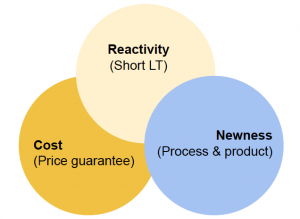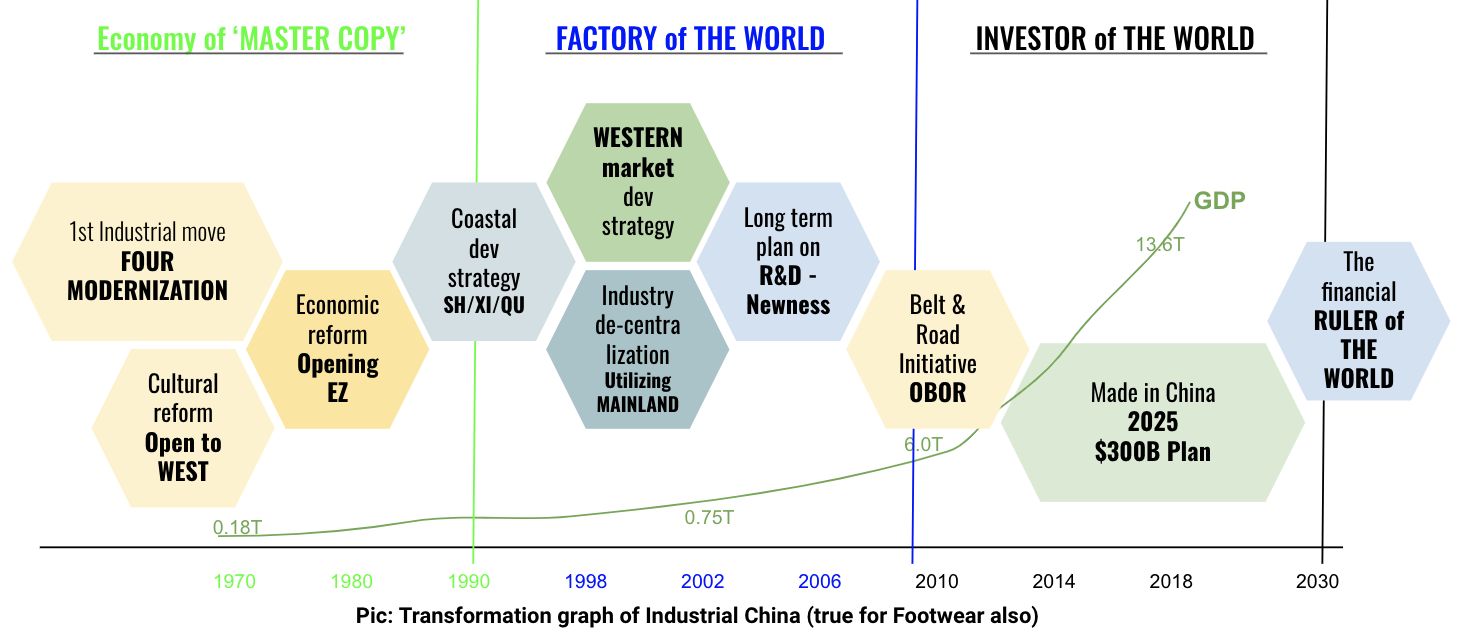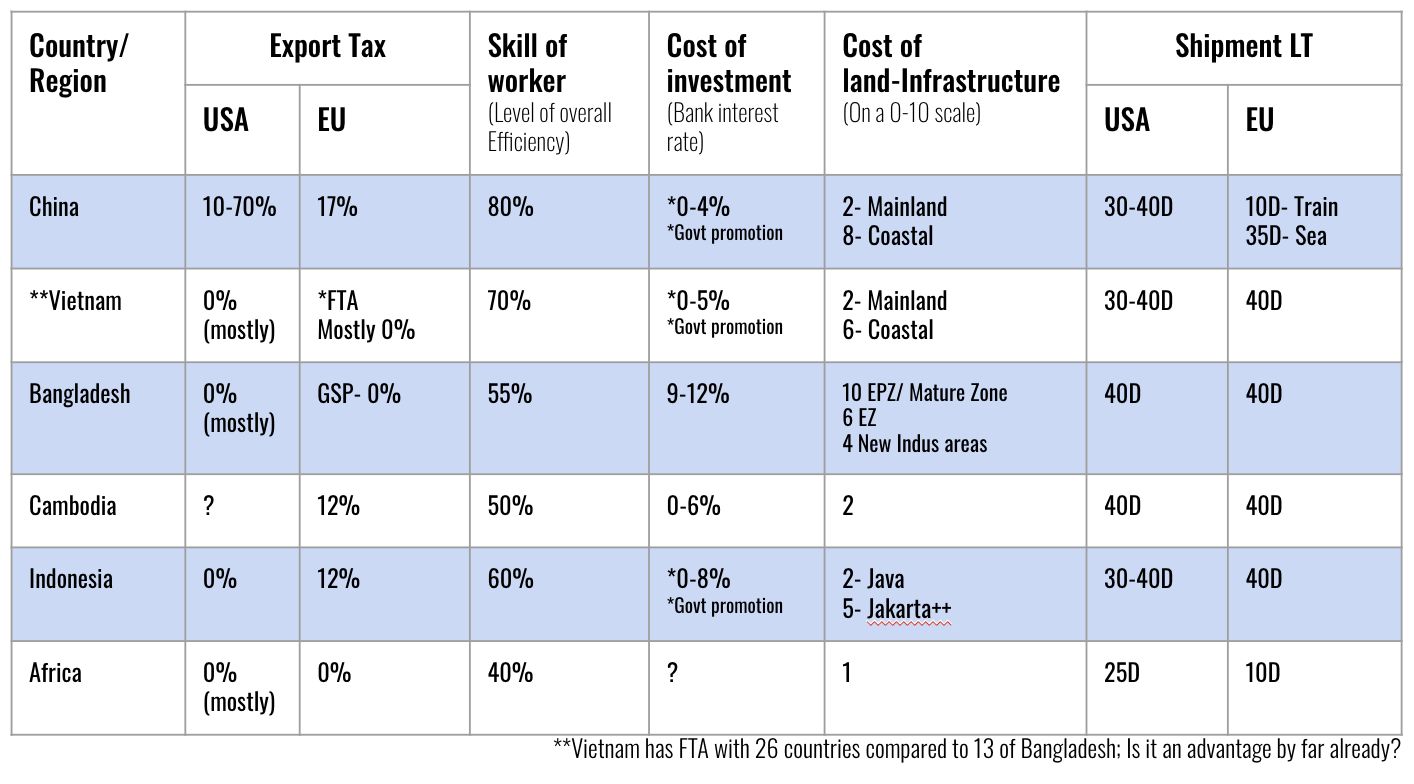Chapter: Flying geese of ‘FOOTWEAR’
Let’s start with an explanation of this interesting theory of ‘Flying geese paradigm’ (Japanese: FifliffMa Hepburn: GankO keitai-ron); a theory derived by a profound Japanese scholar, Kamane Akamatsu.
In simple words, Industry of a particular trade will move from one country to another depending on the competitive advantages offered; i.e, desirability shift. Less developed countries will catch up with the advanced part of a regional hierarchy where the production of commoditized goods would continuously move from the more advanced countries to the less advanced ones.
Well, this definition brings another term that requires a clarification, `desirability’; i.e attractivity of a country. What does it mean? Can we define it with competitive advantage? Yes, almost. Desirability of country is the ‘maximum’ match between competitive advantage of a country and the need from a purchaser.
In case of Bangladesh, the competitive advantage of Bangladesh is low cost of labor’. Desirability of Bangladesh will be high if (only if) a purchaser is looking for ‘low cost shoe’ (FOB, $15) requiring strong involvement of labor force to manufacturing line.
In short, the competitive advantage of Bangladesh can create desirability if at least 2 of the followings are true,
- Low cost shoe < $15
- Non-automated SAM > 85%
- Labor cost > 10% of FOB
On the contrary, if the purchaser is looking for an innovative-functional shoe, in semi or fully automated production line, if the labor cost comes at the lower end of priority, Bangladesh won’t shine as desirable anymore.
The most general competitive advantage expected from a manufacturing country can be depicted in a triangle;
- REACTIVITY (Seasonality/ Unreliable sales forecast (Covid context!)> To manage strong uncertainty.
- NEWNESS (Innovation/ New technology)> To drive pioneering design and technology.
- COST (Price pressure/ Low possibility of automation)> To drive competitive permanent mass market needs.

And in the real world, there is no country offering absolute advantage of reactivity or low cost or newness exclusively. It’s rather a suitable mix chosen by purchasers as per their ‘customized’ needs.
Let’s consider 3 different countries with different sets of competitive advantages,
COUNTRY A: REACTIVITY

Suitable to deliver ‘reactivity’ to meet highly seasonal needs. Manufacturing unit close to purchasers’ retail network, ready to deliver within a LT< 10 days. Example: India for India retail model..
COUNTRY B: NEWNESS

Suitable to offer ‘newness’ in product and process. Generally a mature country with a complete backward linkage from chemical to complete shoe. Example: China.
COUNTRY C: COST COMPETITIVENESS

Suitable to produce shoes at a low cost due to low labor cost. Generally the efficiency of labor force is low, non existence of component network, producing basic non-technical shoes (FOB <$15). Example: Bangladesh 😉
We know by now, the competitive advantage of Bangladesh as a shoe producing country.
– What does it mean to us?
– How does this FLYING GEESE PARADIGM affect us?
Well, eventually industry will be moving to a more desirable and potential (not ready today, but can offer great value in future) destinations; and as a manufacturing country, Bangladesh needs to adapt its competitive advantage of low cost labor towards a new direction.
“Low cost labor has never been a permanent competitive advantage for any country. It was not a case for China, nor for Vietnam, and clearly, won’t be a case for Bangladesh.”

So, first we need to define our direction; define our destination in the next 10/ 20 years. Each step has to be chosen very carefully. And, it must not be forgotten that this transformation is not going to take place overnight. It may take a clear and structured plan for 5 years with a vision of 10-20 years before we can even find our goal.
The best part is, Bangladesh has a beautiful spirit to follow, ‘China’. In the 80’s, China was only a ‘basic’ shoe manufacturing country as ‘Bangladesh in 2021’. And in next 20 years, China could establish themselves as the leaders of innovation and technology for component, process and product in the same shoe industry; Even today, more than 70% technology adopted in top sports brands is delivered from China or Chinese network of R&D.
They have known since the 80’s that the ‘advantage of low cost’ is not permanent. So, they chose to be the best in shoe-innovation to make sure they lead and survive. And most importantly, they planned the game.
We have to ask ourselves,
– What are we today?
– What do we want to become?

Pic: A classic comparison among Indonesia, Cambodia, Vietnam, China and Bangladesh as manufacturer and exporter.
And this is the game, to win it each time, either you write the rules (as China did) or you outplay everyone. You make sure the geese fly in your sky the longest possible time. The longer it stays, the more value the industry adds to the economy of the country.
– How to do that?
– What are the right steps?
– How to make a plan?
Will try to share more soon.
Have a good read.
References:
– https://en.wikipedia.org/wiki/Flying_geese_paradigm
– https://en.wikipedia.org/wiki/Comparative_advantage
– https://aric.adb.org/fta-country
– https://en.wikipedia.org/wiki/Belt_and_Road_Initiative
– https://en.wikipedia.org/wiki/Historical_GDP_of_China
– https://www.visualcapitalist.com/china-investment-opportunity/
– https://www.visualcapitalist.com/china-economic-growth-history/
– https://wits.worldbank.org/CountryProfile/en/Country/USA/Year/LTST/TradeFlow/Export/Partner/by-country/Product/64-67_Footwear
– https://www.cnbc.com/2019/08/02/new-tariffs-on-shoes-has-the-industry-bracing-for-a-hit.html
Author
Hossain Tawhid Imam
A manufacturing industry passionate working as STRATEGIC INDUSTRIAL BUYER with the responsibility to build and deploy worldwide mid and long-term purchasing strategy for Footwear Industrial Division of DECATHLON.



